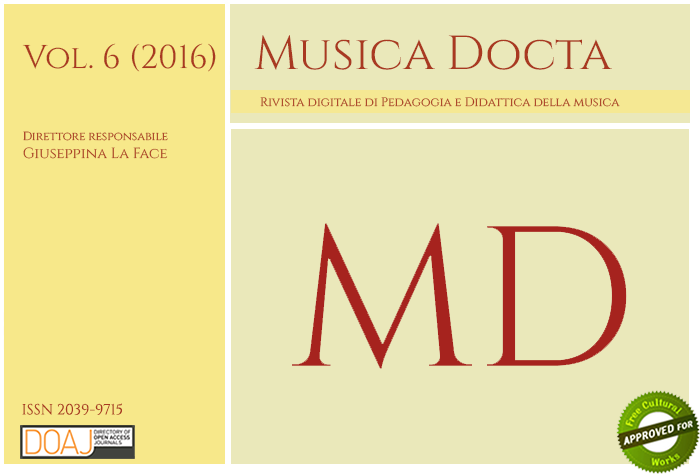ISME and the Twilight of History
DOI:
https://doi.org/10.6092/issn.2039-9715/6565Parole chiave:
International Society for Music Education, Music history, Listening of musicAbstract
In addition to the International Musicological Society there exists an International Society for Music Education, an association (affiliated with UNESCO) that gathers music educators from over 80 countries. Between the end of the last century and the beginning of the present one, the ISME issued three main policy papers: “Declaration of Beliefs for Worldwide Promotion of Music Education” (1994-96); “Policy on Music Education” (2002); and “Vision and Mission: Leading and Supporting Music Education Worldwide” (2006). A comparative analysis of the three ‘manifestos’ reveals that, while in 1994-96 the ISME explicitly included the triad ‘history – culture – aesthetics’ in its conception, and regarded the ‘listening’ of music as an educationally significant activity, after just a few years the first and third notions (‘history,’ ‘aesthetics’) have all but vanished, and music listening has also disappeared from the agenda. The fact that the notion of ‘history’ and the aesthetic approach to musical art have disappeared from the perspective of music educators worldwide may have to do with scruples about political correctness, motivated by the “Mexico City Declaration on Cultural Policies” of UNESCO (1982), where the notion of ‘culture’ had already replaced that of ‘history’. To be sure, this ignorance, or suspicion, about the historical aspects of music production does not in any way facilitate the task of musicologists (or of ethnomusicologists), nor that of music education teachers.Downloads
Pubblicato
Come citare
Fascicolo
Sezione
Licenza
Copyright (c) 2016 Lorenzo Bianconi
I diritti d'autore di tutti i testi nella rivista appartengono ai rispettivi autori senza restrizioni.
La rivista è rilasciata sotto una licenza Creative Commons Attribuzione Condividi allo stesso modo 4.0 Internazionale (codice legale completo).
Vedere inoltre la nostra Open Access Policy.
Metadati
Tutti i metadati dei materiali pubblicati sono rilasciati in pubblico dominio e possono essere utilizzati da ognuno per qualsiasi scopo. Questi includono i riferimenti bibliografici.
I metadati – riferimenti bibliografici inclusi – possono essere riutilizzati in qualsiasi formato senza ulteriori autorizzazioni, incluso per scopo di lucro. Chiediamo cortesemente agli utenti di includere un collegamento ai metadati originali.






